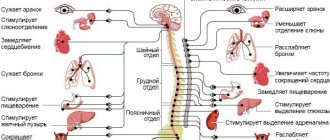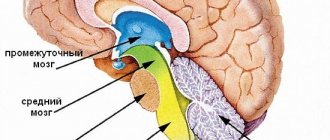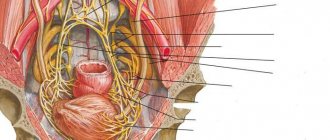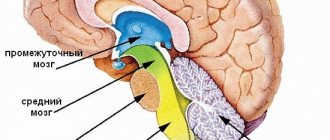Structure of the hearing organ
Sounds surround a person from birth. There are 3 sections of the hearing organ:
- outer ear;
- middle ear;
- inner ear.
The outer ear is the visible part of the organ. It is represented by the auricle and the external auditory canal. The concha is a funnel-shaped cartilage covered with skin. On its surface there are various formations: pits, curls, hills. They help improve sound quality, make it louder and direct it into the ear canal.
The fibers of the ear muscles are attached to the concha. In the process of evolution, man has lost the ability to “move his ears” in order to more accurately localize sounds; these muscles work in rare “lucky” people. The skin of the shell has sebaceous and sweat glands.
The external auditory canal is a winding canal, the length of which is slightly more than 2 cm, and the diameter is up to 0.7 cm. In it, the sound signal continues to be amplified and transmitted to the middle ear. The passage is lined with skin containing sebaceous and sulfur glands. Earwax is a yellowish substance that provides hydration to the canal and protection against infectious agents. When accumulated and compacted, it forms plugs that disrupt the movement of the eardrum. This can lead to conductive hearing loss.
Describing the structure of the hearing organ, anatomists indicate that the outer part of the canal has cartilaginous walls, and the part in contact with the middle ear has bone walls. The structures of the middle and inner ear are located in the body of the temporal bone.
The eardrum is a thin membrane covered on the outside with skin and on the inside with mucous membrane. In young children, it has an opening that exposes the middle ear to the outside environment and is more vulnerable to infection. It closes by 3 years.
The middle ear is a cavity whose volume is slightly more than 1 cubic centimeter. It contains three small auditory ossicles, which are connected to each other in a chain:
- hammer;
- anvil;
- stapes.
They are named so because of their resemblance to everyday objects. The stapes connects to the window of the vestibule. The middle ear is also connected to the nasopharynx via the Eustachian tube.
The inner ear is the most bizarre formation of the human hearing organ. It consists of:
- vestibule (vestibulum);
- snails;
- semicircular canals.
The organ of hearing includes only the cochlea. It contains lymphatic fluid and stretches fibers (the main membrane). Each of the fibers is like a small string and “responds” (resonates) to a sound of a certain frequency. There are about 25 thousand of these fibers. On the wall of the cochlear canal there is a receptor field, which consists of nerve (hair) cells - the organ of Corti. The death of hair cells can lead to sensorineural hearing loss.
Understanding analyzers
One of the most important functions of the nervous system is receiving and analyzing information about changes in external and internal environmental conditions.
The nervous system carries out this function with the help of analyzers. The nervous system receives information, processes it, and on this basis the body’s response program is executed. The concept of analyzers was introduced by I.P. Pavlov. Analyzers consist of three parts, anatomically and functionally connected: the receptor, peripheral part of the analyzer; conductive part - nerve pathways along which information is transmitted to the central part of the analyzer; nerve centers in the cerebral cortex, in which information is analyzed.
The receptor part is represented by nerve cells that perceive irritations. Depending on the nature of the stimulus, photoreceptors, mechanoreceptors, chemoreceptors, thermoreceptors, and pain receptors (nociceptors) are distinguished.
What is usually called the sense organ is the peripheral part of the analyzer. In humans, communication with the external environment is carried out using six senses: vision, hearing, taste, smell, touch and balance.
What is the organ of hearing and balance?
The human ear is responsible not only for the perception and further transmission of sound information. The inner ear is the organ of hearing and balance. This is a complex formation in which a wave of mechanical vibrations, like sea surf, spreads through the lymphatic fluid and sways the processes of nerve cells, forming an electrical impulse. This signal carries information about the volume, duration, and pitch of sound to the brain.
Another part of the inner ear is the organ of balance (vestibular apparatus). It consists of: the vestibule, the three semicircular canals located in it, the utricle and the sac. The vestibule is a round-shaped cavity with a diameter of about 5 mm. It is located between the canals and the cochlea. The canals are mutually perpendicular and at the junction with the vestibule they have expansions - ampoules. The channels are filled with endolymphatic fluid.
The utricle and saccule are fields of nerve cells that perceive various irritations. A change in body position is registered by the receptors of the uterus and causes a reflex reaction of the muscles, helping a person maintain balance. The vibration is picked up by the ends of the sac.
The vestibulocochlear nerve runs from the organ to the brain.
Functions of the hearing organ
When talking about the functions of the hearing organ, physiologists describe them in accordance with their anatomical structures. So, each department has its own specific tasks:
- catches sounds and directs them further (outer ear);
- transmits sound waves (outer and middle ear);
- protects against infections, loud sounds, damage to internal parts (outer ear, eardrum);
- transforms sound energy into electrical energy (inner ear).
The functions of hearing are evolutionarily closely related to danger notification and communication in the community. In order to maintain your ability to hear for a long time, you must follow simple rules for preventing hearing loss.
Characteristics of human analyzers
We became acquainted with the most important general characteristics of analyzers, such as sensitivity thresholds, discrimination threshold, or differential threshold. Let's take a closer look at individual types of analyzers.
Visual analyzer. Vision is of paramount importance for humans. The visual analyzer allows us to get an idea of an object, its color, shape, size, whether the object is in motion or at rest, its distance from us, and the potential danger it poses.
Visual perception begins with a photochemical process. Under the influence of light, substances located between the outer layer of the retina and the choroid decompose, stimulating the endings of the nerve elements of the eye. At the same time, a visual image appears in the corresponding area of the brain. The cerebral cortex synthesizes the details of the visual act and determines our attitude to the visual image.
The human visual analyzer perceives electromagnetic radiation with wavelengths in the range from 0.38 microns to 0.76 microns.
Our eye reacts directly to brightness,
which represents the ratio of the luminous intensity (measured in candelas -
cd
) emitted by a given surface to the area of that surface.
Brightness is thus measured in cd/m2
.
At very high brightnesses (more than 30,000 cd/m2
), a blinding effect occurs.
Brightness up to 5000 cd/m2 is hygienically acceptable.
| Fig.3. Spectral sensitivity of the eye |
The most important characteristics of the visual analyzer are light, contrast and color sensitivity.
Light sensitivity. Light sensitivity is different for different regions of the visible spectrum and is taken as unity at a wavelength of 0.555 microns. The brightness sensitivity range is very large. Thus, the lower threshold of sensitivity corresponds to only a few quanta of light, and the upper threshold, at which the effect of blinding is created, is approximately 3 × 104 cd/m2
.
Contrast sensitivity determines the degree of perceived difference between two luminances separated in space or time, i.e. allows you to answer the question how much an object must differ in brightness from the background in order to be visible. Contrast sensitivity depends on the brightness of the background, the area of the signal, and its duration.
Color sensitivity.
The eye distinguishes seven primary colors and more than a hundred of their shades. The optical analyzer includes two types of receptors: cones and rods. The first are chromatic (color) vision devices, the second are achromatic (black and white). When the energy of the acting waves is equal, differences in their lengths are felt as differences in the color of light sources or the surfaces of objects that reflect it. The visual analyzer has a certain spectral sensitivity, which is characterized by the relative visibility of monochromatic radiation; greater visibility during the day corresponds to the yellow-orange part of the spectrum, and at night or at dusk - green-blue. The spectral sensitivity of the human eye is shown in Fig. 3.
At a wavelength of 0.555 µm, the maximum sensitivity of the visual analyzer is thus achieved. This feature of vision is taken into account when designing safety equipment or objects that must be easily detected (for example, the clothing of road workers, an astronaut suit, an airplane black box).
Visual acuity. When assessing the perception of spatial characteristics, the main concept is visual acuity
, which is characterized by
the minimum angle
at which two points are visible as separate.
Visual acuity depends on lighting, contrast, object shape and other factors. With increasing illumination, visual acuity increases. As contrast decreases, visual acuity decreases.
Visual acuity also depends on the location of the image projection on the retina.
Inertia of vision. The sensation caused by the light signal persists for a certain time, despite the disappearance of the signal or a change in its characteristics, for 0.1 - 0.2 s. It is known that when exposed to an intermittent light stimulus, a sensation of flickering occurs. Due to the inertial properties of vision, these flickers at a certain frequency merge into an even, non-blinking light. The frequency at which flickers disappear is called the critical flicker fusion frequency. In the case where flickering light is used as a signal, the optimal frequency is in the range of 3-10 Hz.
Inertia of vision, in addition, causes
a stroboscopic effect
. It is as follows: if the time separating discrete acts of observation is less than the time of preservation of the visual image (0.1 - 0.2 s), then the observation is subjectively felt as continuous. In this case, for example, an illusion of movement occurs during intermittent observation of individual objects or an illusion of immobility (slowing down of movement), which occurs when a moving object periodically takes its previous position. In particular, when illuminated with pulsating light, rotating parts of equipment appear motionless and pose a danger to humans.
Line of sight. When perceiving objects in two-dimensional and three-dimensional space, a distinction is made between field of view and depth vision. The binocular field of vision covers 120-160° in the horizontal direction, 55-60° in the vertical direction and 65-72° in the vertical direction. When color is perceived, the size of the visual field decreases. The optimal visibility zone is limited by the field: up - 25°, down - 35°, right - °, left 32°. Depth vision is associated with the perception of space. Thus, the error in estimating absolute distance at a distance of up to 30m averages 12% of the total distance.
Hearing analyzer. A significant part of information about the environment, including various dangers, comes to a person in the form of sound signals. As is known, sound is vibrations of an elastic medium; a sound wave propagates in air, water, and solids and is a carrier of energy, which is called sound power or intensity J. The main parameters of sound signals are, therefore, intensity and frequency,
which are subjectively perceived in auditory sensations as
volume and height.
But the organ of hearing (auditory receptor) perceives root mean square sound pressure - i.e. sound pressure averaged over time T0. For the human hearing organ, the averaging time T0 is 30 ¸ 100 ms. Sound pressure is related to sound intensity by dependence
J = ,
where r
— air density,
s
— speed of sound in air.
Sensitivity thresholds. The lower threshold (threshold of audibility) depends on the frequency of perceived sounds. At the so-called reference frequency of 1000 Hz, the hearing threshold is about 2×10-5 Pa . The upper threshold is the pain threshold, which is about 105 Pa . The relationship between intensity and frequency determines the perceived loudness of a sound. A person evaluates as equally loud sounds that have different frequencies and intensities, which is illustrated by the curves of equal loudness shown in Fig. 4. The abscissa axis shows the frequency values f
in hertz (Hz), along the ordinate - sound pressure levels in decibels (see below).
Differential threshold. The absolute differential threshold (frequency discrimination threshold) is approximately 2-3 Hz. The relative differential threshold is almost constant and equal to 0.002. The maximum sensitivity of the auditory analyzer lies in the frequency range 3..5 kHz (see Fig. 5).
| Rice. 4. Equal Loudness Curves |
| Rice. 5. Sensitivity curve S of the auditory analyzer |
It was said above that the sensitivity of the auditory analyzer in terms of sound pressure lies in the range of 2 × 10-5 Pa ... 105 Pa . The sound intensity corresponding to the hearing threshold is ~10-12. It is inconvenient to work with such units. level and a special unit “Bel” (in honor of Bell, the inventor of the telephone) were introduced
Intensity level
LJ = log,
where J0 is the lower sensitivity threshold for sound intensity.
Bel is a fairly large unit. The entire perceived range of sounds fits into only 13-14 B, so in practice a unit 10 times smaller is used - “decibel” [dB].
,
You can write a similar expression for sound pressure by substituting the expression for intensity into the formula. Then we get a value called the level
sound pressure:
, (1.4.9)
where P0
— hearing threshold equal to 2×10-5 Pa (at a frequency of 1000 Hz).
Skin sensitivity.
Skin sensitivity as a means of protection is of great importance, it is usually divided into three types:
· Sensation of touch and pressure
(tactile sensitivity);
· sensation of warmth and cold;
feeling of pain
.
Tactile analyzer. The tactile analyzer perceives sensations that arise when various mechanical stimuli (touch, pressure) act on the skin surface. The absolute threshold of tactile sensitivity is determined by the minimum pressure of an object on the skin surface, which produces a barely noticeable sensation of touch.
Sensation thresholds are approximately:
- for the tips of the fingers 3 g/mm2, on the back of the finger - 5 g/mm2, on the back of the hand - 12 g/mm2, on the stomach - 26 g/mm2 and on the heel - 250 g/mm2. The discrimination threshold is on average approximately 0.07 of the initial pressure value.
The tactile analyzer has a high spatial localization ability. The temporary threshold of tactile sensitivity is less than 0.1 s. A characteristic feature of the tactile analyzer is the rapid development of adaptation, i.e. disappearance of the feeling of touch or pressure. The adaptation time depends on the strength of the stimulus for different parts of the body and varies from 2 to 20 s.
Temperature sensitivity. Temperature sensitivity is characteristic of all organisms that have a constant body temperature. Skin temperature is slightly lower than body temperature and varies for individual areas on the forehead, for example, 34-35°C; on the feet 25 - 27°C. The average temperature of skin areas free from clothing is 30 – 32.
Two types of receptors have been discovered in human skin
.
Some react only to cold, others only to heat. Spatial thresholds depend on stimulating factors during contact exposure, for example, sensation occurs already on an area of 1 mm2, radiation - starting from 700 mm2. Latent, i.e.
The latent period of temperature sensation (inertia of sensation) is approximately 250 ms. The absolute threshold of the temperature sensitivity region is determined by the minimum perceptible change in the temperature of skin areas relative to
logical zero
, i.e. own temperature of a given area of skin. For thermal receptors it is approximately 0.2°C, for cold receptors 0.4°C. The discrimination threshold, or differential threshold, is approximately 1°C.
Pain sensitivity. Pain is often the only signal warning of external danger or trouble in the condition of any human organ. Usually, accidental touching of sharp, hot or cold objects that can destroy the skin is accompanied by an involuntary reflex movement - “out of danger.” Thanks to such protection, which is a protective reaction to irritation received from outside, a person in many cases promptly assesses the danger of burns, injuries, etc. that threaten him. and takes appropriate security measures.
Previously, it was believed that there were no special receptors for pain sensitivity, since pain sensations arise in any analyzer if the magnitude of the stimulus exceeds the upper absolute threshold. However, free nerve endings were subsequently discovered in the epithelial layer of the skin, which turned out to be specialized pain receptors
. There is a contradictory relationship between tactile and pain receptors. They manifest themselves in the fact that the lowest density of pain receptors occurs in those areas of the skin that are richest in tactile receptors, and vice versa. The contradiction is due to the difference in the functions of receptors in the life of the body. Painful sensations cause defensive reflexes, in particular, the reflex of withdrawing from the stimulus. Tactile sensitivity is associated with orientation reflexes.
The biological meaning of pain is that it, being a danger signal, mobilizes the body to fight for self-preservation. Under the influence of a pain signal, the work of all body systems is restructured and its reactivity increases.
The pain sensitivity threshold for the skin of the abdomen is 20 g/mm2, for the fingertips - 300 g/mm2, the latent period of pain sensation is about 370 ms. The critical fusion frequency of discrete pain stimuli is 3 Hz. In the area of pain, there is an almost direct relationship between sensation and stimulus.
It should be borne in mind that the protective role of pain ends after it is marked by consciousness.
In the future, for example, in case of severe multiple trauma, pain only complicates the body’s efforts to self-heal the damage, and in some cases is dangerous in relation to the so-called “pain shock.”
Smell. Smells are perceived by humans using special receptors (cells located in the mucous membrane of the nasal concha). Humans have about 60 million olfactory cells located in the mucous membrane of the middle part of the nasal turbinates, covering only five
square centimeters. However, due to the fact that the olfactory cells are covered with a huge number of cilia, the area of their contact with odorous substances is 5 - 7 square meters.
The sensation of smell occurs when particles of a substance enter the mucous membrane of the olfactory area and excite the olfactory cells. The processes of these cells, forming the olfactory nerve, transmit excitation to the central nervous system. Protection against the penetration of odorous substances into the body that are dangerous to life and health (ether, chloroform, ammonia, etc.) is carried out by reflexively slowing down breathing and stopping it for a short time. It is characteristic that many odors that are harmless to the body do not cause reflexive cessation of breathing.
The sense of smell is an extremely subtle sense. According to physiological studies, a person smells certain substances (hydrogen sulfide, musk and others) contained in the air, even when chemical and spectral analyzes do not detect them.
The features of the olfactory analyzer, including its high sensitivity to certain odorous substances contained in the air, can serve as a signal warning of the danger of the penetration of various substances into production premises, for example, due to an unexpected violation of the tightness of equipment, various gas pipelines, etc. In practice, the features of the olfactory analyzer are already used, for example, to warn about the danger of poisoning and explosion of natural gas used as fuel in production and at home. For this purpose, an odorless gas, but with a potential danger of poisoning or explosion, is odorized (i.e., given an odor) with particularly odorous harmless substances. In this case, the perception of odor signals danger and the need to take appropriate safety measures.
In the future, odorization can also be used to saturate the air of industrial premises with subtle aromas, for example, forests, fields, etc. This will help create an “emotional climate” in production that promotes the highest productivity.
The absolute threshold of smell in humans is measured in fractions of a milligram of a substance per liter of air.
But the differential threshold is high, on average 38%. There is currently no generally accepted classification of olfactory sensations.
Taste. In physiology and psychology, the four-component theory of taste is widespread, according to which there are four types of elementary taste sensations: sweet
,
bitter
,
sour
and
salty
. All other taste sensations are their combinations. The absolute thresholds of the taste analyzer, expressed in solution concentrations, are approximately 10,000 times higher than those of the olfactory analyzer.
Taste and olfactory sensations reflect not only the properties of substances, but also the state of the body itself. The discriminative sensitivity of the taste analyzer is quite rough, averaging 20%.
Under the influence of practical activity and special knowledge, the sensitivity of the taste and olfactory analyzer can be significantly developed.
The senses of smell and taste together constitute the so-called organoleptic sensitivity.
Vibration sensitivity. High-intensity vibration with prolonged exposure leads to serious changes in the functioning of all body systems and, under certain conditions, can cause serious illness. With low intensity and duration of exposure, vibration can be useful: it reduces fatigue, increases metabolism, and increases muscle strength.
Special analyzers that sense vibration are unknown. There are several hypotheses about the nature of vibration sensitivity. The range of vibration sensations is high from 1 to 10000 Hz. The highest sensitivity is to a frequency of 200-250 Hz. As they increase and decrease, vibration sensitivity decreases. Vibration sensitivity thresholds are different for different parts of the body. The distal (remote) areas of the human body (for example, hands) have the greatest sensitivity.
Organic sensitivity. The human brain receives information not only from the environment, but also from the body itself. Sensitive nervous apparatus is present in all internal organs. In the internal organs, under the influence of external conditions, certain sensations arise that generate signals. These signals are a necessary condition for regulating the activity of internal organs. Thresholds of organic sensitivity have not been sufficiently studied.
The listed analyzers operate in complex interaction. The core of the entire mechanism of interaction between analyzers is the reflex pathway: permanent and temporary nerve connections between their brain ends. In the process of human development, based on the interaction of analyzers, functional systems are formed, which are the mechanism of perceptual (perceiving) actions.
The structure of these systems is determined by the conditions of human activity and life. If a person finds himself in conditions that are unusual for him, then a conflict may arise between existing functional systems and new requirements. To prevent such violations, it is necessary to rebuild existing functional systems. The process of such restructuring may proceed somewhat differently in different people, depending on the characteristics of their nervous system.
Features of the hearing organ
Human hearing organs are paired. What does this mean? A person can listen with both the right and left ear at the same time. Binaural hearing gives more information about the sound and amplifies it under certain conditions.
If the source of mechanical vibrations is at the same distance from the right and left ears, the signal volume increases by 50%. This means that in case of unilateral impairment, compensation with the help of a hearing aid of even low power significantly improves the quality of life.
Perceiving with two ears is better for determining the localization of sound. Binaural hearing gives:
- surround sound sensation;
- idea of the location of the source.
This helps you avoid danger (such as an approaching car) and isolate useful sounds from all the background noise when talking to one person in a noisy room.
Read more about hearing characteristics in this article.
If you experience any hearing problems, you must urgently undergo a hearing test using professional equipment. If you seek help in time, you have a chance to fully restore your hearing.











